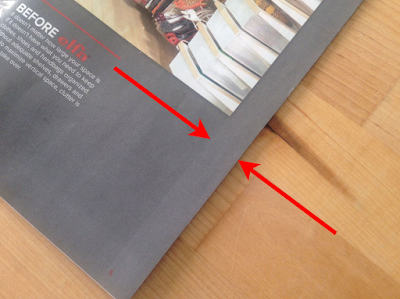Ghosting is when an ink is used on one area of a sheet and a "ghost" or outline of that image appears in another. There are three types of ghosting in offset printing: mechanical, chemical and blanket. The problem occurs on a printing press when rollers distribute ink unevenly because of their inherent design.
In this article I will try and describe each as we have encountered them. If you are looking for remedies to control ghosting, I recommend you check another post here. In this article, I will to define each type separately.
Mechanical ghosting.
To understand this, we need to look at a printing unit roller system.
Notice the yellow ink rollers. They roll against the plate, depositing ink with every revolution. The roller is then depleted of ink in some areas so it get replenished as it turns and comes in contact with other rollers that are feeding it.
The problem is that not all areas need replenishing while others do. The result is that the roller has high ink levels in some areas and low in others. When it touches the plate again, this uneven ink layer will transfer to the plate and then to the blanket.
That is mechanical ghosting. The printing process itself cannot fully eliminate it, but it can be minimized.
It is noteworthy though from a mechanical perspective what press designers try to do to minimize this effect. For example, the yellow rollers above show equal diameter. Many presses will make these rollers of different diameter so that the identical image problem is not magnified on the roller that follows it. This diameter is calculated carefully by the manufacturer.
Printing press makers will take this a step further and make a third plate roller (referred to as an ink form roller). This roller sometimes also has a different diameter. What is more, this roller will oscillate laterally as it rides against the other rollers that feed it. This helps move the ink around more to spread it to the areas that need it.
Here is an example of what mechanical ghosting looks like:
 |
| Mechanical ghosting. |
Chemical Ghosting
Chemical ghosting happens when the image on one side of the printed sheet effects the image on the other side. This is usually only apparent after the images are printed.
This type of ghosting is a little more complex and has to do with the gloss of the finished image. Light is reflected at varying degrees from the ink film and paper. Papers also differ in their ability to trap light.
In the drying process, gloss is lost or obtaining depending on the ink or drying process. This difference in reflection causes an image to show through to the other side of the sheet.
 |
| Chemical ghosting: the image below shows through to the other side. |
Blanket Ghosting
Previous print jobs will caus piling on the blanket. When running a new job with a different image area, the images from the previous job can show in the print. This makes cleaning the blankets important between jobs.
Long print runs can also cause images to be embedded into the blanket. Though it is not bad enough to be considered a smashed blanket, the depression is enough to effect certain images. The solution is to just change the blanket.
Conclusion
Mechanical, chemical and blanket are all difficult to predict and cause an undesirable result in the printed image. Please see my other article that explains what can be done on press to minimize ghosting.


Comments
Post a Comment